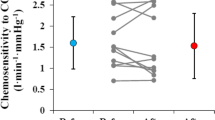Abstract
We assessed the central-chemoreflex ventilatory responses to carbon dioxide in six male volunteers using a hyperoxic rebreathing technique. Hyperventilation prior to rebreathing allowed both the threshold and the sensitivity of the response to be measured. We used immersion in water to control the body temperature (tympanic). The water temperature was adjusted to be either thermo-neutral or hot so that body temperature either remained normal [+ 0.2 (0.04)°C, mean (SEM)] or was elevated by 1.5 (0.08)°C. The sensitivities of the central-chemoreflex ventilatory responses to carbon dioxide were increased at elevated body temperatures, changing from a mean of 1.8 (0.2) 1·min−1. Torr−1 to 2.7 (0.1) 1·min−1·Torr−1. However, the thresholds did not change with temperature, and the mean threshold was 48(1) Torr at both normal and elevated temperatures. For all of the volunteers, ventilation was increased at elevated body temperatures for all levels of carbon dioxide, mainly by changes in respiratory frequency due to reductions in expiratory times. At subthreshold levels of carbon dioxide, mean ventilation changed significantly from 6.3 (1.1) 1·min−1 at normal temperatures to 10.8 (1.9) 1 · min−1 at elevated temperatures. Heart rates also increased significantly with temperature, changing from a mean of 66 (4) beats·min−1 to 102 (3) beats·min−1 at threshold levels of carbon dioxide. The mean rates of rise of carbon dioxide partial pressure during rebreathing were significantly increased with temperature as well, changing from 0.075 (0.008) Torr·min−1 to 0.089 (0.004) Torr·min−1. We concluded that elevating the body temperatures of our subjects not only increased their ventilation, heart rates and metabolic rates at all levels of carbon dioxide, but it also increased the sensitivity of their central chemoreflex ventilatory responses to carbon dioxide. Despite these increases, the thresholds of the central-chemoreflex ventilatory responses to carbon dioxide remained unchanged.
Similar content being viewed by others
References
Alexander SC, Workman RD, Lambertsen CJ (1962) Hyperthermia, lactic acid infusion, and the composition of arterial blood and cerebrospinal fluid. Am J Physiol 202:1049–1052
Bonde-Petersen F, Schultz-Pedersen L, Dragsted N (1992) Peripheral and central blood flow in man during cold, thermoneutral, and hot water immersion. Aviat Space Environ Med 63:346–350
Casey K, Duffin J, McAvoy GV (1987) The effect of exercise on the central-chemoreceptor threshold in man. J Physiol (Lond) 383:9–18
Choukroun M-L, Varene P (1990) Adjustments in oxygen transport during heat-out immersion in water at different temperatures. J Appl Physiol 68:1475–1480
Cotes JE (1955) The role of body temperature in controlling ventilation during exercise in one normal subject breathing oxygen. J Physiol (Lond) 129: 554–563
Cunningham DJC, O'Riorden JLH (1957) The effect of a rise in the temperature of the body on the respiratory response to carbon dioxide at rest. Q J Exp Physiol 43: 329–345
Dempsey JA, Forster HV, Gledhill N, Dopico GA (1975) Effects of moderate hypoxemia and hypocapnia on CSF [II+] and ventilation in man. J Appl Physiol 38:665–674
Duffin J, McAvoy GV (1988) The peripheral-chemoreceptor threshold to carbon dioxide in man. J Physiol (Lond) 406:15–26
Euler C von, Herrerro F, Wexler I (1970) Control mechanisms determining rate and depth of respiratory movements. Respir Physiol 10: 93–108
Glantz SA (1981) Primer of biostatistics. McGraw-Hill, Toronto, pp 284–292
Hey EN, Lloyd BB, Cunningham DJC, Jukes MGM, Bolton DPG (1966) Effects of various respiratory stimuli on the depth and frequency of breathing in man. Respir Physiol 1:193–205
Irsigler GB (1975) The carbon dioxide response curve in normal adults. S Afr Med J 49:13–16
Pearson SB, Cunningham DJC (1973) Some observations on the relation between ventilation, tidal volume and frequency in man in various steady and transient states. Acta Neurobiol Exp 33:177–188
Pleschcka K (1969) Der Einfluss der Temperatur auf die elektrische Aktivität des Nervus Phrenicus. Pflügers Arch 308: 357–381
Read DJC (1967) A clinical method for assessing the ventilatory response to carbon dioxide. Aust Ann Med 16:20–32
Read DJC Leigh J (1967) Blood-brain tissue PCO2 relationship and ventilation during rebreathing. J Appl Physiol 23:58–70
Saxton C (1975) Respiration during heat stress. Aviat Space Environ Med 46:41–46
Shephard RJ (1988) PAR-Q Canadian home fitness test and exercise screening alternatives. Sports Med 5:185–195
Strange-Petersen E, Vejby-Christensen H (1975) Effects of a rise in body temperature on the pattern of breathing in man. J Physiol (Lond) 250:40–41P
Strange-Petersen E, Vejby-Christensen H (1977) Effects of body temperature on ventilatory response to hypoxia and breathing pattern in man. J Appl Physiol 42:492–500
Vejby-Christensen H, Strange-Petersen E (1973) Effect of body temperature and hypoxia on the ventilatory CO2 in man. Respir Physiol 10: 93–108
Widdicombe JG, Winning A (1974) Effects of hypoxia, hypercapnia and changes in body temperature on the pattern of breathing in cats. Respir Physiol 21:203–221
Zapata P, Larrain C, Fadic R, Ramirez B, Loyola H (1993) Thermal effects on the chemosensory drive of ventilation. In: Data PG, Aker H, Lahiri S (eds) Advances in experimental medicine and biology vol 337 (Neurobiology and cell physiology of chemoreception). Plenum, New York, pp 371–378
Author information
Authors and Affiliations
Rights and permissions
About this article
Cite this article
Baker, J.F., Goode, R.C. & Duffin, J. The effect of a rise in body temperature on the central-chemoreflex ventilatory response to carbon dioxide. Eur J Appl Physiol 72, 537–541 (1996). https://doi.org/10.1007/BF00242287
Accepted:
Issue Date:
DOI: https://doi.org/10.1007/BF00242287




